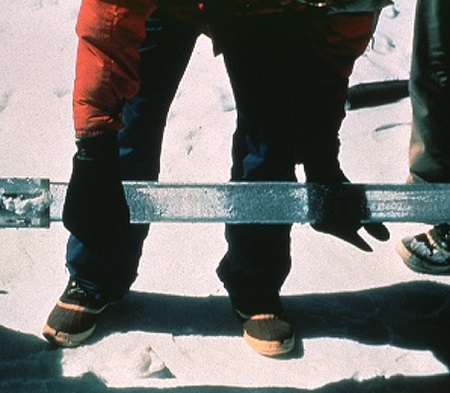Good evening, Dr. Zoomie! I was reading something about being able to study isotopes to lean about temperatures in the past. How does that work?
Boy does this take me back a few decades – to when I was in grad school, taking a class in environmental geochemistry. And – yes – it turns out that studying carefully selected isotopes can teach us about environmental temperatures in the past – in fact, this is one of the mainstays of studies of climate in the past. Here’s how it works.
Every element has multiple nuclides – atoms with the same number of protons but more or less neutrons. All hydrogen atoms, for example, have a single proton; for most of them that’s all there is (written as 1H). But a small fraction of hydrogen atoms has a neutron as well- this is called deuterium (2H). An even smaller fraction of hydrogen atoms has a second neutron and is called tritium (3H); deuterium is stable but tritium is radioactive. All of these are present in nature and, chemically, they all behave the same way. This means that we can have water molecules that are oxygen bonded to hydrogen, deuterium, or tritium – all chemically the same, but all with different mass.
Oxygen is the same – oxygen comes in two naturally occurring stable isotopes, mostly 16O with traces of 18O. This means that the mass of a water molecule can be as little as 18 atomic mass units (amu) or as much as 24 amu (two tritium atoms and one 18O). And it’s this difference in mass that helps to make water a good paleothermometer (a way to tell temperatures in the past). For the purpose of the rest of this, we’ll ignore tritium because it’s got a relatively short half-life and can’t be detected beyond a century or two – far shorter than the time frames we’re interested in.
As a rule of thumb, heavy isotopes tend to go into denser materials at any given temperature. This means that if we put water into a jar and seal the jar, as the water evaporates, the water vapor will have more 1H and 16O than will the liquid water; the liquid water, on the other hand, will have more 2H and 18O than will the water vapor.
So…that’s at any given temperature, but what happens if the temperature changes? Well…now it gets a little more complicated.
It takes more energy to lift something heavy compared to something that’s light – it’s just as relevant to a molecule as it is to a box you’re trying to pick up. On the molecular level, this means that “light” water (1H16O) evaporates more easily than does “heavy” water (2H16O or 2H18O). So if we study the isotopes in a variety of water and water vapor samples we can figure out which samples were warmer or colder when they formed by looking at how many of the water molecules contain the heavier isotopes. This process is called fractionation.
What makes things more…interesting…is that fractionation takes place when water evaporates (more light water in water vapor than in the water remaining behind) as well as when it rains or snows (more heavy water in the rain or snow than in the water vapor remaining in the atmosphere). This means that, as rain and snow fall, the ratio of these stable isotopes in the remaining water vapor will be changing, just as it will change in the future rain and snow that fall. This process is called Rayleigh fractionation.
All of these processes have been studied extensively and we are pretty good at determining the ratio of 16O to 18O, 2H to 1H, and various weights of water molecules in sea water, water vapor, rain, and snow at various temperatures. What this means is that we can drill through the ice in Antarctica and study the various isotopes of oxygen and hydrogen to determine the temperature at the time the snow fell that eventually turned into the ice that we’re studying.
There are more isotopes than hydrogen and oxygen that can be used for this sort of thing – or for other uses. The heavier isotope 13C is concentrated in living organisms compared to the environment; 13C-enhanced “chemo-fossils” have been used to identify traces of ancient life in rocks that are billions of years old and scientists have discussed looking at this to identify traces of life on other worlds. And other isotopic systems are used as well – but oxygen and hydrogen isotopes are the most useful.
So – yes – you heard right! By studying the ratio of heavy and light isotopes of hydrogen, oxygen, and other elements we can learn quite a bit about the temperatures that prevailed at the time the snow fell and compacted into ice. Doing studies such as this, we’re able to drill ice cores that go back hundreds of thousands of years and to determine the temperatures at the time the snow fell. This, in turn, can be used to develop temperature profiles at that location over the centuries or millennia represented by the ice core.
One last comment – the Earth hasn’t had much snow or ice for the majority of its history; the glaciers and ice caps we have today are rare in the history of our planet. This means that, for those ice-free times, we can’t study ice cores to reconstruct the Earth’s temperature…but it doesn’t mean that we can’t know the temperature of the Earth at that point in time. It just means we have to study other media – corals, clam shells, and the like.
